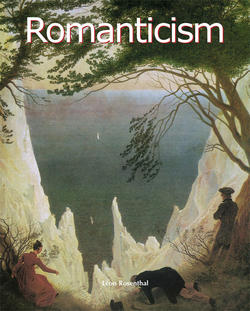Romanticism

Реклама. ООО «ЛитРес», ИНН: 7719571260.
Оглавление
Léon Rosenthal. Romanticism
I. The Precursors of Romanticism
II. The Romantic Period
III. The Romantic Inspiration
IV. The Expressive Moods of Romanticism
Conclusion
Extracts from Literary Texts
Jean-Jacques Rousseau (1712–1778) Reveries of the Solitary Walker
James MacPherson (1736–1796) Fragments of Ancient Poetry
Johann Wolfgang von Goethe (1749–1832) Faust
William Blake (1757–1827) Poems. The Echoing Green
Johann Christoph Friedrich von Schiller (1759–1805) The Bride of Messina
Germaine Necker, Baroness de Staël-Holstein, called Madame de Staël (1766–1817) Germany
Benjamin Constant (1767–1830) Adolphe
François René Chateaubriand, vicomte de Chateaubriand (1768–1848) René
William Wordsworth (1770–1850) Lyrical Ballads. The Thorn
Georg Philipp Friedrich Freiherr von Hardenberg, called Novalis (1772–1801) Hymn to Night
Friedrich von Schlegel (1772–1829) Philosophy of Life
Ernst Theodor Amadeus Hoffmann (1776–1822) The Devil’s Elixir
Joseph von Görres (1776–1848) Bayard, or the Death of the True Hero
Henri Beyle, called Stendhal (1783–1842) The Charterhouse of Parma
George Gordon, Lord Byron (1788–1824) The Prayer of Nature
James Fenimore Cooper (1789–1851) The Last of the Mohicans
Alphonse de Lamartine (1790–1869) Poetical Meditations. The Lake
Percy Bysshe Shelley (1792–1822) Alastor or the Spirit of Solitude
John Keats (1795–1821) Poems
Heinrich Heine (1797–1856) Intermezzo
Alfred de Vigny (1797–1863) Chatterton
Victor Hugo (1802–1885) Hernani
Aurore Dupin, Baroness Dudevant, called George Sand (1804–1876) The Devil’s Pool
Alfred de Musset (1810–1857) The Confession of a Child of the Century
Mikhail Yuryevich Lermontov (1814–1841) A Hero of Our Time
Major Artists
Hubert Robert (Paris, 1733–1808)
Johann Heinrich Füssli, called Henry Fuseli (Zürich 1741 – London 1825)
Francisco de Goya y Lucientes (Fuendetodos, 1746 – Bordeaux, 1828)
John Robert Cozens (London, 1752–1797)
William Blake (London, 1757–1827)
Antoine Jean Gros, Baron Gros (Paris, 1771–1835)
Caspar David Friedrich (Greiswald, 1774 – Dresden, 1840)
Joseph Mallord William Turner (London, 1775–1851)
John Constable (East Bergholt, 1776 – London, 1837)
Philipp Otto Runge (Walgast, 1777 – Hamburg, 1810)
Théodore Géricault (Rouen, 1791 – Paris 1824)
Arie Scheffer, called Ary Scheffer (Dort, 1795 – Argenteuil, 1858)
Eugène Delacroix (Saint-Maurice, 1798 – Paris, 1863)
Richard Parkes Bonington (Nottingham, 1802 – London, 1828)
Théodore Chassériau (Sainte-Barbe-de-Samana, 1819 – Paris, 1856)
François Rude (Dijon, 1784 – Paris, 1855)
Pierre Jean David, called David d’Angers (Angers, 1788 – Paris, 1856)
Jean-Jacques Pradier, called James Pradier (Geneva, 1790 – Bougival, 1852)
Antoine-Louis Barye (Paris, 1796–1875)
Jean-Étienne Chaponnière (Geneva, 1801 – Mornex, 1835)
Antoine Augustin Préault, called Auguste Préault (Paris, 1809–1879)
Jean-Baptiste Carpeaux (Valenciennes, 1827 – Courbevoie, 1875)
Bibliography
Отрывок из книги
The Romantic Age! Youth, ardour, a generous faith in art, excessive passions; amongst fevers, exaggerations, errors, it was a period really full of ideas, personalities and works. Literary Romanticism has been subject to great arguments and violent controversy, particularly because it was considered to be responsible for divisive religious, political or social tendencies. Romantic art received less attention, perhaps because it seemed comparatively unimportant. However, it is possible to dissociate the two movements. They were linked not because of personal friendships developing by chance between a few painters and writers but because those movements, in their different ways, share in the same origin. Born from a common mindset, they had developed in the same atmosphere. There was a Romantic generation the members of which applied their minds to literature and the arts as well as to science, philosophy, politics or industry – in fact to all the forms of activity to which their minds could possibly be applied.
The canons of Romanticism were first formulated in Germany at the end of the eighteenth century. As early as 1770 and 1780 representatives of Sturm und Drang, a movement both literary and political, meaning literally ‘storm and stress’, were rebelling against the Enlightenment and its values. Friedrich von Schiller and Johann Wolfgang von Goethe were amongst the followers of Sturm und Drang, who made a religion of individualism and nature as advocated by Jean-Jacques Rousseau in the middle of the eighteenth century. However, despite that wave of protest the rejection of classical rules was only partial. Sturm und Drang turned its back on classical traditions and literary conventions but its canons of beauty were still based on Antiquity and prescribed the perfection and harmony of forms. Classicism was totally rejected as a whole by the intellectuals contributing to the journal Athenaeum, amongst whom were Wilhelm von Schelling and Novalis representing the ‘Iena Romantics’ group. In contrast with earlier values they put an emphasis on the feeling of infinity, mysticism and the expression of irrationality.
.....
Musée national du château et des Trianons, Versailles.
Eugène Delacroix, The Massacre at Chios, 1824.
.....